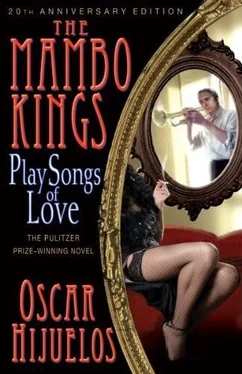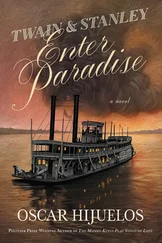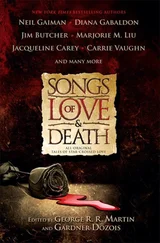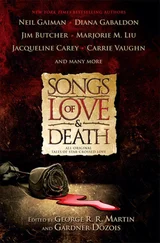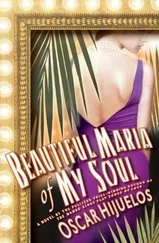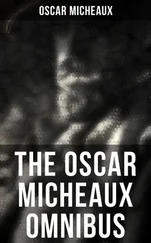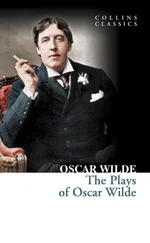He’d get up on the stage, dancing before the microphone while his musicians took the music forward. The glory of being on a stage with his brother Nestor, playing for crowds of café-society people who jumped, bounced, and wriggled across the dance floor. While Nestor soloed, Cesar’s heavy eyelids fluttered like butterfly wings lilting on a rose; for drum solos his hips shook, his arms whipped into the air: he’d take backwards dance steps, gripping his belt with one hand and a crease of trouser with the other, hiking them up, as if to accentuate the valiant masculinity therein: outline of big prick through white silk pantalones. Piano taking a ninth chord voicing behind a solo, he’d stare up into the pink and red spotlights, giving the audience a horse’s grin. Woman in a strapless dress dancing a slow, grinding rumba, staring at Cesar Castillo. Old woman with hair coiffed upward into a heavenly spiral, staring at Cesar. Teenage girl, Miss Roosevelt High School Class of 1950, thin-legged and thinking about the mystery of boys and love, staring at Cesar Castillo. Old ladies’ skin heating up, hips moving like young girls’ hips, eyes wide open with admiration and delight.
Audiences everywhere seemed to like them, but if there was one place they “owned,” it was the Imperial Ballroom on East 18th Street and Utica Avenue, Brooklyn. Here they were the house band — hired at first because of Miguel Montoya, but kept on because of Cesar and Nestor’s popularity. They were constantly playing contests which awarded $25 prizes for the Best Peg Pants, Loudest Shirts, Best-Looking Woman, Best Dancer Holding an Umbrella, Shapeliest Legs, Weirdest Shoes, Most Outrageous Hat, and, on one Saturday night, the Best Baldhead contest, for which a huge crowd turned out. Their greatest moment of glory at the Imperial came on that memorable night when they engaged in a battle in the war between Cuba and Puerto Rico. Under the sterling hip-swinging, pelvis-grinding admiralship of their singer, Cesar Castillo, the orchestra pulled a victory out of, to quote the Herald’s entertainment column, “the ravages of da-feet.”
And, on another night, Cesar met one of his best and lifelong friends, Frankie Pérez. This was in 1950 and the orchestra was playing one of Cesar and Nestor’s original compositions, “Twilight in Havana.” Frankie was a hammy dancer, knew every rumba, mambo, and cu-bop* step on earth. He was a suavecito who had been a natural wizard on his toes since he was a kid in Havana, and could make any partner look good dancing with him. At that time, he’d make the rounds of the major ballrooms of the city three or four nights a week: the Park Palace, the Palladium, the Savoy, the Imperial. That night he was dressed in a green zoot suit with a pink oversized purple-brimmed hat, cream-colored Cuban-heeled shoes, and green argyle socks. Dancing happily near the stage, and oblivious to the troubles of the world, he heard pop, pop coming out of the manager’s office. Then the crashing of glass and screaming. Someone shouted, “Get down!” and people scattered across the dance floor and hid behind the mirrored columns and under the tables. Two more pops and the orchestra stopped playing, the musicians ducking behind their music stands and jumping down off the stage and hitting the floor.
Two men came running out of the manager’s office onto the dance floor and they spun around firing off shots as they made their way out toward the door. One of them was thin and eagle-beaked and carried a satchel of money. The other man was heavier and seemed to have trouble running, as if he had a lame leg or had been hit by the gunshots fired from the office. They looked as if they were going to make it, but once they got outside they ran into a barrage of gunfire; some cops had been driving by when they heard the commotion. One of the robbers was hit in the back of the head, the other surrendered. Later, when everyone was huddling by the bar and throwing down drinks, Cesar and Nestor struck up a conversation with Frankie. When they finished with their drinks, they made their way out into the street, where a crowd had gathered. The dead man was still lying face-down in the gutter. He was broad-shouldered and dressed in a pinstriped jacket. Nestor had no stomach for this, but Cesar and Frankie made their way over to the corpse to get a better look. Leaning up against a brick wall, their solemn faces peering out into the world from the shadows, they sadly and confoundedly contemplated the dead man’s fate. As he watched, Cesar had one foot lifted behind him, the bottom of his sporty cordovan shoe pressed to the wall, and was lighting a cigarette and listening to all the sirens when a white camera flash went off. Foof. Aside from becoming friends that night, he and Frankie ended up on page 3 of the next morning’s Daily News, part of the photograph whose caption read: BALLROOM ROBBER DIES IN POOL OF BLOOD.
A spectacular evening among so many spectacular evenings. How the rum flowed then, Jesus, how the bottles of booze multiplied along with the thick latex prophylactics and quivering female thighs like the miracle of fish and bread.
VISAS IN HAND AND SPONSORED by their cousin Pablo, they had turned up in New York as part of the wave of musicians who had been pouring out of Havana since the 1920s, when the tango and rumba crazes swept the United States and Europe. That boom had started because so many musicians lost their jobs in pit orchestras when talkies came in and silent movies went out. It was stay in Cuba and starve to death or head north to find a place in a rumba band. Even in Havana, with so many hotels, dance halls, and nightclubs, the scene was overcrowded. When Cesar had gone there in 1945, with the naïve idea of making it big, he became just one of a thousand bolero singers struggling to earn a living. Havana was jammed with first-rate underpaid singers and musicians like himself and Nestor, island musicians who played arrangements that sounded quaintly archaic next to the big brass American jazz bands like those of Artie Shaw, Fletcher Henderson, and Benny Goodman, who were much in vogue at the time. A musician’s life in Havana was poor, sociable. Pretty-boy singers, trumpet players, and congueros gathered everywhere — in the arcades, plazas, and bars. With the Paul Whiteman Orchestra playing in the casino, the more authentic Cuban music was relegated to the alleys. Even musicians who were in the popular tropical orchestras of Enric Madriguera and René Touzet used to complain how badly they were being treated by the mobsters who ran the casinos and paid the Cuban musicians shit. Ten dollars a night, with cleaning charges for uniforms, black skins and mulattoes in one door, white musicians in another, no drinks on the house, no overtime, and Christmas bonuses of watered-down resealed bottles of whiskey. This at clubs like the Tropicana and the Sans Souci.
The best — Olga Chorens, Alberto Beltrán, Nelson Piñedo, Manny Jiménez — worked in clubs with names like the Night and Day, the New Capri, Lucky Seven. The fabulous Ernesto Lecuona at the Montmartre, Beny More at the Sierra.
The brothers had mainly worked in Havana as strolling troubadours and in a cheap social band called the Havana Melody Boys. They’d played in the lounge of a gambling casino, entertaining audiences of soaked-with-alcohol gamblers and spinster tourists from the American Midwest; shaking cocktail mixers filled with shot, strumming guitars and blowing horns. They wore frilly-sleeved mambo shirts and orange toreador pants so tight their paterfamilias gnarled up like big tree knots. (Another version of the Havana Melody Boys picture tucked inside the soft cloth pocket in the Mambo King’s cane suitcase that he’d brought with him into the Hotel Splendour, in a clump of old photographs, letters, and song ideas: a row of frilly-sleeved mambo musicians in white-striped blue pantalones, seated on a bamboo stage that is made up to look like a hut. There are nine musicians. A window opens behind them to a fake view of Havana Harbor, the sky thick with stars and a half-moon.) They had even made a record back then featuring the Fabulous Cesar Castillo, something called “El Campesino ” (he’d make a later version of this with the Mambo Kings in 1952). Printing about a thousand copies of this 78 as a demonstration record, they sent them around to local radio stations, even got a few into the jukeboxes of Havana Amusement Park and up at La Playa de Maríanao. It was not a hit and got lost in the sea of boleros and ballads coming out of Havana at that time. A thousand crooners and female torch singers, and for each one a black plastic disc, a record for each foam-curled wave in the rippling mambo sea.
Читать дальше
